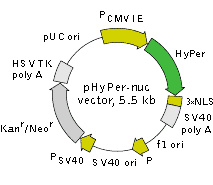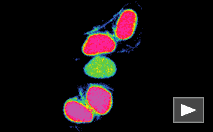
|
||||||||||
|
||||||||||

|
|
||||||||||||||||||||||||||||||||||||||||||||||||||||
The vector sequence has been compiled using the information from sequence databases, published literature, and other sources, together with partial sequences obtained by Evrogen. This vector has not been completely sequenced. |
|||||||||||||||||||||||||||||||||||||||||||||||||
 Download
|
| ||||||||||||||||||||||||||||||||||||||||||||||||
Vector description
pHyPer-nuc is a mammalian expression vector encoding nuclear-targeted HyPer (see reporter description). HyPer codon usage is optimized for high expression in mammalian cells (humanized) [Haas et al., 1996]. Three copies of the nuclear localization signal (NLS) fused to the HyPer C-terminus provide for efficient translocation of HyPer to the nuclei of mammalian cells [Fischer-Fantuzzi and Vesco, 1988].
pHyPer-nuc vector can be used as a source of HyPer-NLS hybrid sequence. The vector backbone contains unique restriction sites that permit its excision and further insertion into expression vector of choice. Alternatively, HyPer-NLS coding sequence can be amplified by PCR.
Note: The plasmid DNA was isolated from dam+-methylated
The vector backbone contains immediate early promoter of cytomegalovirus (PCMV IE) for protein expression, SV40 origin for replication in mammalian cells expressing SV40 T-antigen, pUC origin of replication for propagation in
SV40 early promoter (PSV40) provides neomycin resistance gene (Neor) expression to select stably transfected eukaryotic cells using G418. Bacterial promoter (P) provides kanamycin resistance gene expression (Kanr) in
Expression in mammalian cells
pHyPer-nuc vector can be transfected into mammalian cells by any known transfection method. CMV promoter provides strong, constitutive HyPer expression in eukaryotic cells. If required, stable transformants can be selected using G418 [Gorman, 1985].
Propagation in
Suitable host strains for propagation in
Location of features
PCMV IE: 1-589
Enhancer region: 59-465
TATA box: 554-560
Transcription start point: 583
HyPer-nuc fusion
Start codon (ATG): 603-605
HyPer coding sequence: 603-2036
Nuclear localization signals (NLS): 2058-2130
Stop codon: 2148-2150
SV40 early mRNA polyadenylation signal
Polyadenylation signals: 2290-2295 & 2319-2324
mRNA 3' ends: 2328 & 2340
f1 single-strand DNA origin: 2387-2842
Bacterial promoter for expression of Kanr gene
-35 region: 2904-2909
-10 region: 2927-2932
Transcription start point: 2939
SV40 origin of replication: 3183-3318
SV40 early promoter
Enhancer (72-bp tandem repeats): 3016-3087 & 3088-3159
21-bp repeats: 3163-3183, 3184-3204 & 3206-3226
Early promoter element: 3239-3245
Major transcription start points: 3235, 3273, 3279 & 3284
Kanamycin/neomycin resistance gene
Neomycin phosphotransferase coding sequences:
Start codon (ATG): 3367-3369
Stop codon: 4159-4161
G->A mutation to remove Pst I site: 3549
C->A (Arg to Ser) mutation to remove BssH II site: 3895
Herpes simplex virus (HSV) thymidine kinase (TK) polyadenylation signal
Polyadenylation signals: 4397-4402 & 4410-4415
pUC plasmid replication origin: 4746-5389
References:
- Fischer-Fantuzzi L, Vesco C. Cell-dependent efficiency of reiterated nuclear signals in a mutant simian virus 40 oncoprotein targeted to the nucleus. Mol Cell Biol. 1988; 8 (12):5495-503. / pmid: 2854199
- Gorman C. High efficiency gene transfer into mammalian cells. In DNA cloning: A Practical Approach, Vol. II. Ed. D. M. Glover. (IRL Press, Oxford, U.K.). 1985; 143-90.
- Haas J, Park EC, Seed B. Codon usage limitation in the expression of HIV-1 envelope glycoprotein. Curr Biol. 1996; 6 (3):315-24. / pmid: 8805248
Notice to Purchaser:
HyPer-related materials (also referred to as "Products") are intended for research use only. Some elements of these materials may be covered by third party patents issued and applicable in certain countries. No license under these patents is conveyed expressly or by implication to the recipient of the materials. Users of these materials may be required to obtain a patent license depending upon the particular application and country in which the materials are received or used.
|
Copyright 2002-2023 Evrogen. All rights reserved. Evrogen JSC, 16/10 Miklukho-Maklaya str., Moscow, Russia, Tel +7(495)988-4084, Fax +7(495)988-4085, e-mail:evrogen@evrogen.com |



